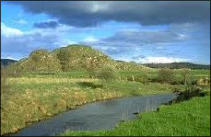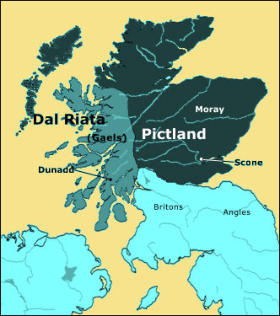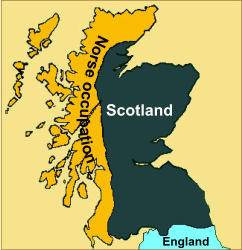



The Gaels
A Gaelic Kingdom
Dunadd - it means “fort by the river Add” - is an Iron Age hillfort near Kilmartin in Argyll. It is believed to be the capital of the ancient kingdom of Dál Riata (approximates to Argyll today). This is the site at which the Gaelic kings of Dal Riata (also known as Dalriada) were inaugurated. Just below the upper enclosure at Dunadd, are some stone carvings which include a footprint. It is thought to have formed part of Dal Riata’s coronation ritual. By placing his foot in the carved footprint, the new king was considered to be married to the land of his kingdom. Clan legend has it that from around the third century AD, the Gaels of Dal Riata, a small kingdom in northern Ireland began migrating to south-west Scotland. About two hundred years later, Fergus Mor, the king of Dal Riata in Ireland, moved his court to his territory of the same name in mainland Scotland, making Dunadd the new capital, and giving up claim to the land in Ulster. The truth may be much more complicated - see Wikipedia for details.Scotland
The Gaels in the west and Picts in the east of Scotland had the occasional conflict with each other, but the peoples did intermingle. In the year 839, they fought side by side in a battle somewhere in what is now Morayshire, against a common foe; the Vikings. The kings of the Gaels and Picts were both killed resulting in some internal strife until in 843 they agreed on a single king, Kenneth mac Alpin, thus uniting the two cultures. This was the beginning of what was then called the Kingdom of Alba. The term “Scotland” began to be used in the 11th century and was commonplace by the end of the 14th. The Picts adopted Gaelic culture, so little evidence remains of the Picts from their time. However, it has been reported in the The Telegraph newspaper that recent DNA studies have shown that approximately 10% of Scottish men have a Pictish DNA marker, so I am happy to report that the Picts are still alive and well in Scotland! Continued Viking raids and, ultimately, settlement on the islands and western mainland, forced the royal household to uproot itself and move eastwards. Dunadd was abandoned and a new court was set up at Scone, near Perth, deemed safe from Viking raids. Repeated attacks and settlement by the Norse forced the western clans to flee; some into Pictland, some into the mountains and forests of the western highlands, some into exile in Ireland. At that point, Dal Riata no longer existed as a Gaelic kingdom. Meanwhile, the Scottish kings were gaining and losing land to England. The border between Scotland and England was very fluid in the 11th and 12th centuries.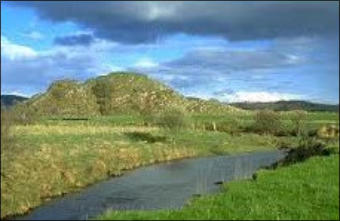
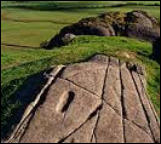
© Walter Jardine 2016
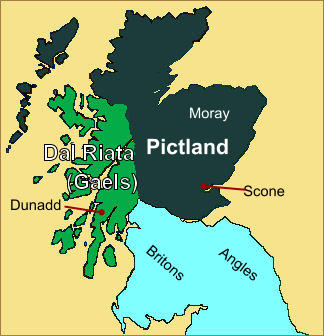
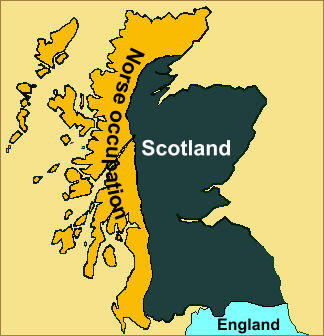


Novel





The Gaels
A Gaelic Kingdom
Dunadd - it means “fort by the river Add” - is an Iron Age hillfort near Kilmartin in Argyll. It is believed to be the capital of the ancient kingdom of Dál Riata (approximates to Argyll today). This is the site at which the Gaelic kings of Dal Riata (also known as Dalriada) were inaugurated. Just below the upper enclosure at Dunadd, are some stone carvings which include a footprint. It is thought to have formed part of Dal Riata’s coronation ritual. By placing his foot in the carved footprint, the new king was considered to be married to the land of his kingdom. Clan legend has it that from around the third century AD, the Gaels of Dal Riata, a small kingdom in northern Ireland began migrating to south-west Scotland. About two hundred years later, Fergus Mor, the king of Dal Riata in Ireland, moved his court to his territory of the same name in mainland Scotland, making Dunadd the new capital, and giving up claim to the land in Ulster. The truth may be much more complicated - see Wikipedia for details.Scotland
The Gaels in the west and Picts in the east of Scotland had the occasional conflict with each other, but the peoples did intermingle. In the year 839, they fought side by side in a battle somewhere in what is now Morayshire, against a common foe; the Vikings. The kings of the Gaels and Picts were both killed resulting in some internal strife until in 843 they agreed on a single king, Kenneth mac Alpin, thus uniting the two cultures. This was the beginning of what was then called the Kingdom of Alba. The term “Scotland” began to be used in the 11th century and was commonplace by the end of the 14th. The Picts adopted Gaelic culture, so little evidence remains of the Picts from their time. However, it has been reported in the The Telegraph newspaper that recent DNA studies have shown that approximately 10% of Scottish men have a Pictish DNA marker, so I am happy to report that the Picts are still alive and well in Scotland! Continued Viking raids and, ultimately, settlement on the islands and western mainland, forced the royal household to uproot itself and move eastwards. Dunadd was abandoned and a new court was set up at Scone, near Perth, deemed safe from Viking raids. Repeated attacks and settlement by the Norse forced the western clans to flee; some into Pictland, some into the mountains and forests of the western highlands, some into exile in Ireland. At that point, Dal Riata no longer existed as a Gaelic kingdom. Meanwhile, the Scottish kings were gaining and losing land to England. The border between Scotland and England was very fluid in the 11th and 12th centuries.